Re-Osdating,and Pb-H-O isotopecharacteristics,of the Abra Cu-Ag-Pb-Au polymetallic deposit in Western Australia
Chaozhuang Xi·Minghong Zheng·Ling He·Haodong Xia
Abstract The Abra deposit,a large lead-silver-coppergold polymetallic deposit in Western Australia,is located at the eastern of the metallogenic belt of the Jillawarra basin in the Bangemall basin.The 4th to the 6th rock section of the Irrigully Group of Edmund Series are the principal ore-host strata,composed mainly of sandstone and f ine sandstone.The orebody in Abra can be classified into two types as upper layer-like lead-silver and lower veins or netvein copper-gold.The metal minerals are mainly galena,chalcopyrite,and pyrite,while the gangue minerals are mainly quartz,dolomite,and barite.Both Re-Os isotopic age of the pyrite(1329.5±98 Ma)with the initial(187Os/188Os)=5.0±3.8 and Pb isotopic compositions (206Pb/204Pb=15.914-15.967, 207Pb/204Pb=15.425-15.454, 208Pb/204Pb=35.584-35.667) suggests that the metal minerals were sourced from the wall-rocks.δDV-SMOW values of quartz range from-35‰to-17‰whereasδ18OV-SMOW value rangefrom 12‰to 16‰which indicatesthat the ore-forming f luidsof Abraweremediumlow temperature and medium-low salinity,and were mainly metamorphic water and secondary atmospheric precipitation.When the medium-low temperature oreforming f luids are mixed with oxidizing reducing f luids carrying a large number of metal substances,a large number of ore-forming substances will be precipitated when the physical and chemical conditions change,thus it can be considered that the Abra deposit is a medium-low temperature hydrothermal polymetallic deposit.
Keywords Re-os isotope·Pb-H-O isotope·Abra cu-agpb-au polymetallic deposit·Australia
1 Introduction
The Abra gold polymetallic deposit(Abra deposit)is located at the eastern of the metallogenic belt of Jillawarra basin of the Bangemall basin in Western Australia,about 870 km NNE of Perth(Fig.1).Its coordinate is 24°39′S,118°36′E(Boddington 1990).It was found by air magnetic survey in 1976 and displayed as a concealed ore body by gravity measurement.In 1982,it was conf irmed through the core drilling,and subsequent geological explorations were started.
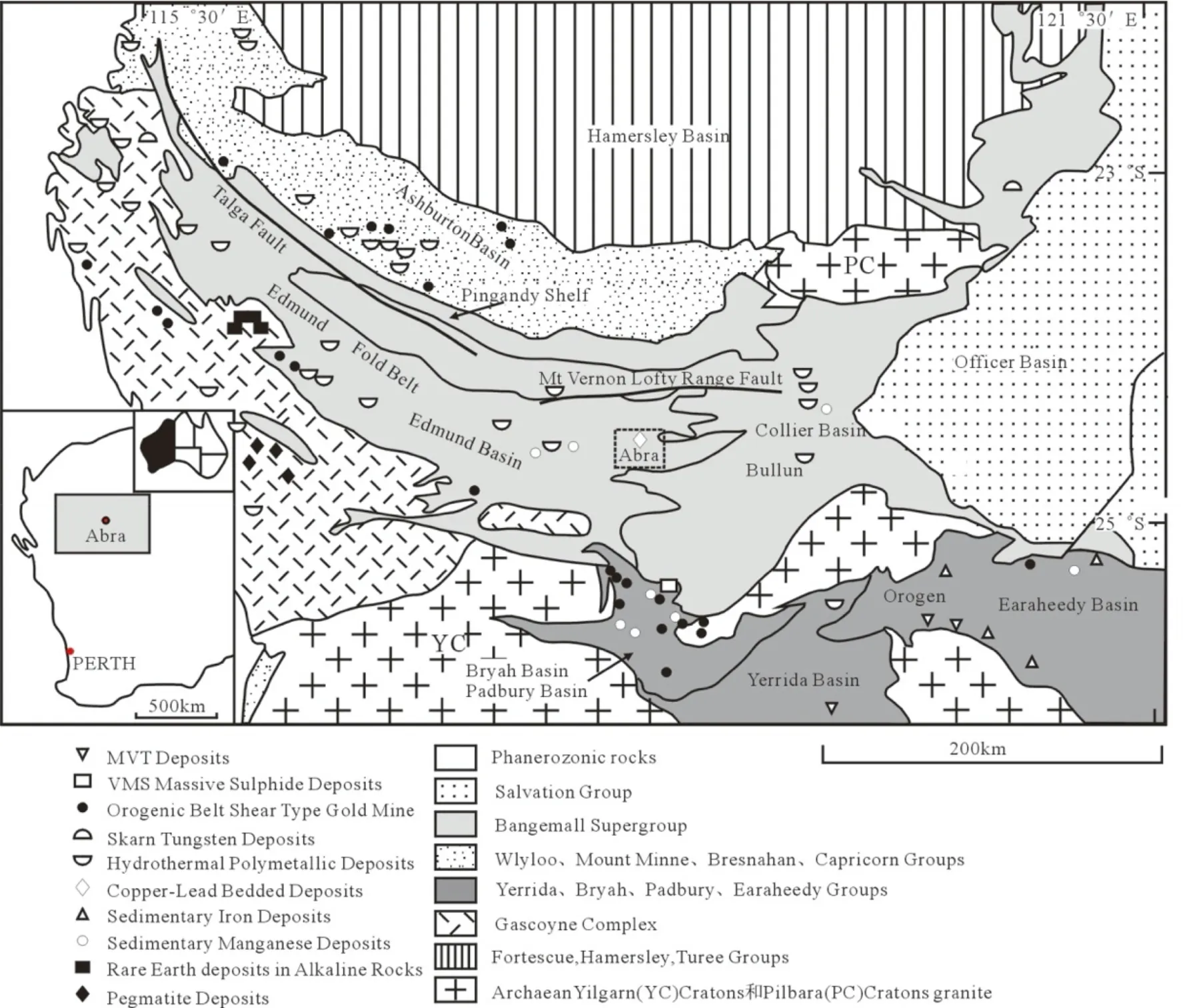
Fig.1 Simplified geological map of the Bangemall Basin showing mineral occurrences(Pirajno 2004)
The Abra mineralization was published by Vogt and Stumpf l(1987);Boddington(1990);Collinsand McDonald(1994);Vogt(1995);Cooper et al.(1998);and Austen(2007).Work on mineralogy,chronology,f luid inclusions,and isotopic geochemistry have been carried out in the Abra deposit,and the mineralization ageand genesisof the deposit have been discussed,but are still controversial(Johnson et al.2011;Cutten et al.2015;Franco et al.2015;Heta et al.2019;Zi et al.2015).
In recent years,there are several studies on the isotope chronology of the Abra deposit,but the reported ages are not consistent with each other.Through the U-Pb isotope dating (Carr 1995),Commonwealth’s Scientif ic and Industria Research Organisation(CSIRO)obtained a conclusion about 1640 Ma,but the later verif ication was quite different from the actual situation,and the obtained age value waswrong;Curtin University and Geological Survey of Western Australia(GSWA)carried out SHRIMPdating research on monazite(Rasmussen et al.2010),yielding 1385±20 Ma,which represents the age of one phase f luid f low.
Due to lack of direct mineralization age and systematic f luid characteristic data,the current genetic understanding of the Abra deposit is highly controversial,and the following three viewpoints are mainly summarized as follows:(1)Iron oxide type(IOCG type)copper and gold deposit(Vogt 1995);(2)SEDEX deposit(Boddington 1990);(3)the Abra deposit can be compared to Spain’s Iberian Pyrite Belt(IBP)analogy(Pirajno et al.2009).Due to the unclear of the Abra deposit mineralization period,the exploration activities of the deposit have been brought to a halt without signif icant progress.At the same time,the mineralization age of the Abra deposit is not clear,which has seriously affected the understanding and summary of regional metallogenesis.In addition,sources of the oreforming metals and f luid are controversial.Boddington(1990)believed that the Pb and Cu in the Abra Deposit mainly derived from concealed igneous rocks in the basin.While Pirajno(2004)thought that the metallogenic material in the Abra Deposit originated from the bottom strata through hydrothermal cycling extraction and precipitation enrichment.Thus,the work conducts systematic Re-Os isotope chronology,galena Pb isotope and quartz,H,O isotopeto constrain themetallogenic epochs,sourcesof the ore-forming metals,and ore-forming f luid,trying to preliminarily build a metallogenic model,which might help further guide the prospecting work.
2 Regional geologic background
Geotectonic position of the Abra deposit is located in the clastic rock and carbonate formation of the eastern end of the Jillawarra basin which is the secondary basin of the Bangemall basin belonging to the south of the Proterozoic Capricorn orogenic belt.It’s eastern intersects the Collier basin hydrothermal polymetallic metallogenic belt,and western is the Edumund basin hydrothermal polymetallic metallogenic belt.
Structure in the Abra deposit is simple(Fig.2).Itsnorth is a nearly east-west normal fault.Its tendency is north,with 40°inclination and 150 m slip.This fault cuts off the orebody.In the southern,there is a near east-west hidden rupture-the Bazaare fault.Due to the low degree of research,the nature of the fracture is unknown.In the eastern,there issix milesfault(north to east).In the case of core drilling,the Abra deposit outputs in the south wing of a nearly E-W towards rolling anticline.The stratum angle is about 30°.
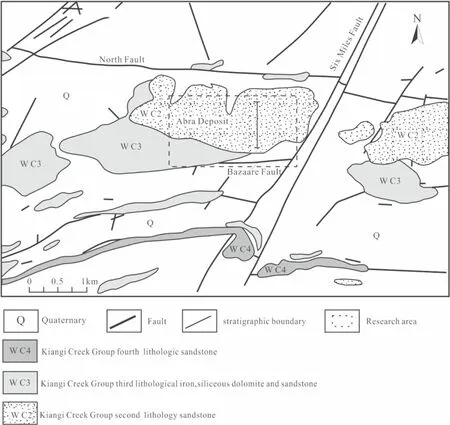
Fig.2 Sketch geological map of Abra deposit(Li et al.2014)
The Bangemall basin is mainly composed of the Bangemall Supergroup-shallow metamorphic sedimentary rocks(Fig.3).The Bangemall Supergroup includes the Edmund Group at thelower and Collier Group at theupper.The exposed lithology in the mining area is mainly sandstone,siltstone,and mudstone of the Kiangi Creek formation of the Collier Group,with a thickness of about 300 m.The 4th to 6th lithology section of the lower Edmund Group and Irrigully Group is a set of sandstone and f ine sandstone with a thickness of over 600 m.The 1st to 3rd lithology section of the Irrigully group are mudstone,mudstone,and chlorite with un-def ined thickness.There is a gradual transition relationship between the 3rd and 4th lithological sections.
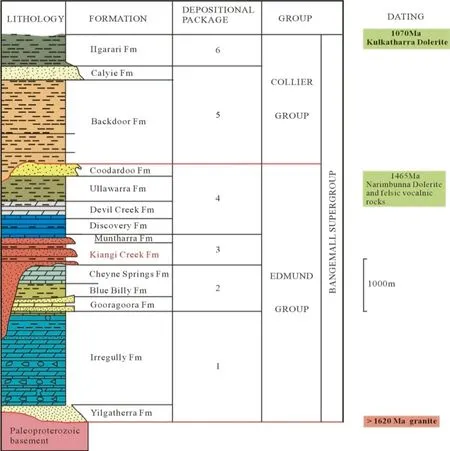
Fig.3 Summary of Bangemall supergroup stratlgraphy(Rasmussen et al.2010)
According to the lithological characteristics,the 4th to 6th section of the Irrigully Group could be divided into the following f ive sub-sections:
1. Red Banded Zone(RBZ),located at the top of the Irrigully Group and bounded by a layer of mudstone above the Kiangi Creek formation.RBZ contains a large amount of hematite,a small number of veinlets of magnetite interspersing hematite,and some largegrained,well-crystallized barite.The mineralization is weak,with occasional lead ore veinlets.The thickness of RBZ is about 50-80 m(Fig.5A);
2. Dolomite Banded Zone(DBZ),mainly distributed in the center of the ore deposit,the dome shape and characterized by dolomite,contents of hematite and barite are less than the RBZ but relatively more abundant magnetite.The mineralization is weak,with some galena in veins.The thickness of the section is about 10-20 m;
3. Black Banded Zone(BBZ),characterized by mass development of magnetite,the contents of hematite and barite are greatly reduced,and barely containing dolomite and occasional quartz vein.The mineralization is intense,with mainly stratified lead mineralization.The content of pyrite increases.The thickness of BBZ is about 80-100 m(Fig.5B);
4. Alteration Banded Zone(ABZ),variegated and gray.The fracture is large and well-developed,f illed with quartz,and highly silicified.Hematite,magnetite,and barite are not developed,about could be found locally.The mineralization is characterized by veins and nets.The lead ore mineralization becomes less intense but chalcopyrite is more abundant.The thickness of ABZ about 80-120 m(Fig.5C,5E);
5. Chlorite Banded Zone(CBZ),light green and celadon.Magnetite,and barite,etc.only occasionally saw in the f issure vein and the net pulse.The mineralization is controlled by fractures,which form large vein and veinletsmineralization.Ore mineralsare dominated by chalcopyrite.It is found that the keratinite can be combined well,and the fractures are f illed with chalcopyrite and pyrite.The thickness exceeds 100 m.Breccia has good join ability and the cracks are f illed with chalcopyrite and pyrite(Fig.5D,F).
3 Deposit geological characteristic
There are two types of ore bodiesof the Abra deposit,leadsilver ore body and copper-gold ore body.The upper part is a stratiform-like lead-silver ore body,and the lower part is a large vein and net vein copper-gold ore body(Fig.4).Ore bodies orientation is NW with the south-facing,dip angle is about 40°to 60°.The thickness of the upper ore body is about 200-250 m,and that of the lower ore body is about 100 m.This ore deposit is a large hidden polymetallic deposit,the main ore body mainly occurs within the scope of the 250 to 800 m.By the end of 2011,it has a proven resource of 107 million t,including the amount of Pb-Ag 93 million t(the average grade Pb 4.1%,Ag10g/t)and Cu-Au resources of 14 million t(average grade Cu 0.6%,Au 0.5 g/t)(Fig.4).
The mineralization types in the Abra deposit can be divided into layers of mineralization(upper)and veins(lower),and net mineralization according to their occurrences.The outputs of stratiform-like mineralization mainly in the red,dolomite,and black segments characterized by the development of the formation of the galena,and particles are smaller(Fig.5G).The development of gig net vein and vein mineralization mainly in the alteration and chlorite,variations of vein width are signif icant(from 0.5 cm to more than 10 cm),characterized by the vein f illing of galena,chalcopyrite,and quartz(Fig.5H).
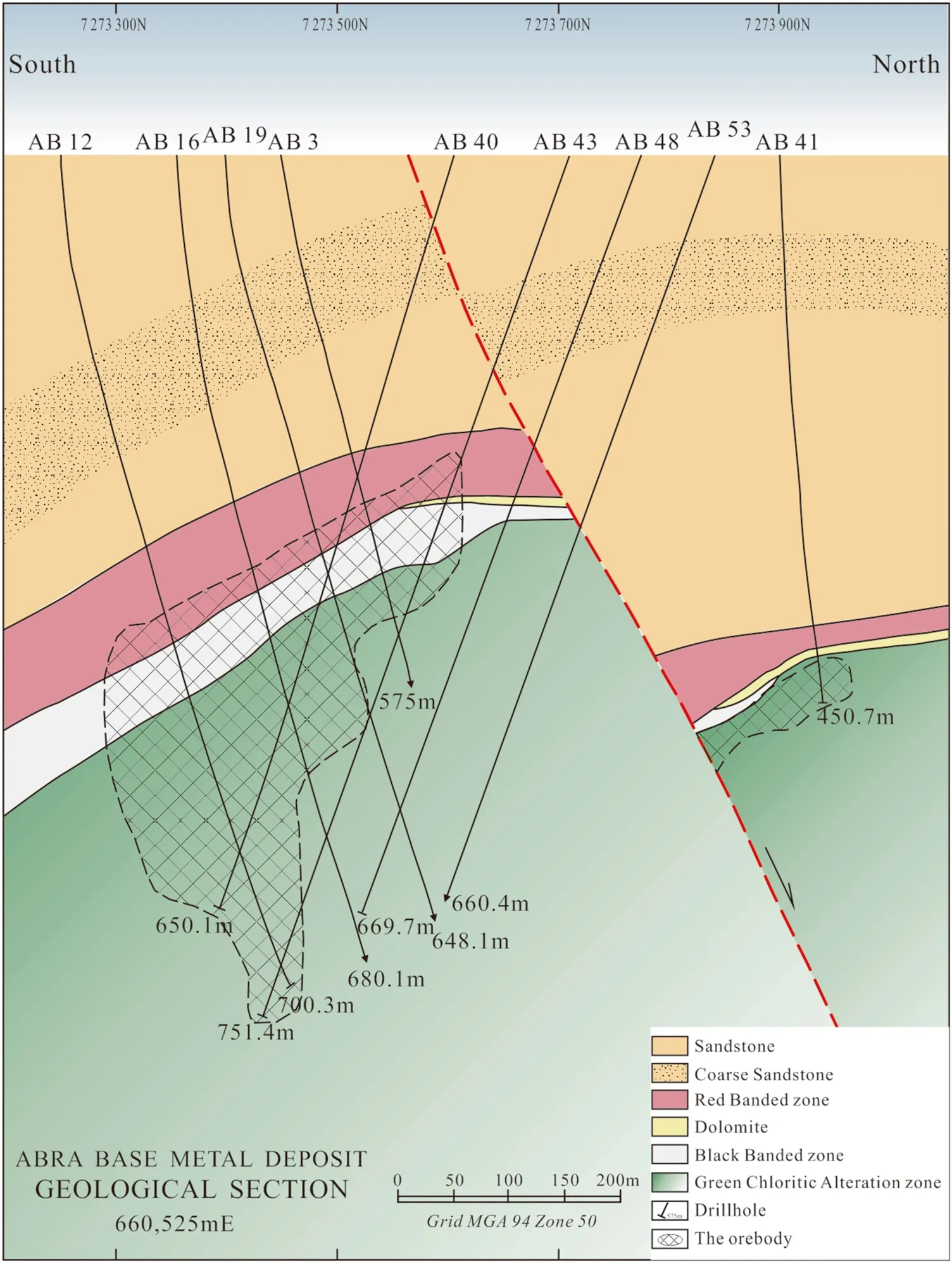
Themineral assemblagesin the Abradeposit aresimple.Metallic minerals are mainly galena,chalcopyrite and pyrite,and a small amount of sphalerite.The gangue minerals are mainly quartz,barite,dolomite et ac.Galena grains are 0.5-2 mm in the upper layer stratiform-like ore block,occasionally more than 2 mm(Fig.5I,J),but in the lower part of alteration and net vein mineralization,the majority of galena are larger than 2 mm.Chalcopyrite is mainly the lower part of the deposit,most of which is an infestation,and closely symbiotic with pyrite(Fig.5K).Pyriteismostly xenomorphic-hypidiomorphic granulewith thesizeof 0.2 mm,symbiosiswith chalcopyrite and galena(Fig.5J).Quartz is a xenomorphic granule with the size of 0.1-0.5 mm,and the carbonate minerals are distributed in the barite granules and f issures(Fig.5L).

Fig.5 Photos and microphotographs of Abra deposit A-Red banded zone;B-Black banded zone;C-Alteration zone;D-Chlorite zone;E-Multistage quartz vein;F-Hydraulic fracture;G-Layered mineralization;H-Vein mineralization;I-Lead and copper ore;J-Galena,chalcopyrite,pyrite symbiotic relationship;K-Chalcopyrite and pyrite symbiotic relationship;L-Quartz,chalcopyrite,magnetite symbiotic relationship;Q-Quartz;Gn-Galena;Hm-Hematite;Mt-Magnetite;Ccp-Chalcopyrite;Py-Pyrite;Chl-Chlorite
4 Sampling and analytical methods
4.1 Samples
Seven representative samples from AB56 and AB59 drilling cores were selected in the main layers of RBZ,BBZ,AB,Z,and CBZ(Table 1).We chose pyrites from the upper layered ore body and the lower vein ore body for Re-Os dating of the ore-forming ages.
In 2009,Abra company carried out studies on Pb,H,O isotope compositions and f luid inclusions from typical samples of RBZ,BBZ,ABZ,and CBZ.The samples are taken from AB24 and AB31 drilling cores.These samples are closely related to Pb-Cu mineralization,which can represent f luid characteristics of metallogenic stages.
4.2 Analytical methods
The pyrite separates for Re-Os isotopic dating are in close association with galena,chalcopyrite,and can represent the metallogenic stage(Fig.5J,K).
The Re-Os isotope analysis was conducted in the Curtin University of Technology by Svetlana G Tessalina,Re and Os abundance and187Os/188Os ratios were measured by inductively coupled plasma mass spectrometer LA-MCICP-MS(Fletcher et al.2004).Seven samples of the pyrite Re-Os isotope were detected.187Os*is the total187Os content.The analysis process of the study was listed in the literature(Du et al.2012).
Pb isotope analysis wascompleted by Commonwealth’s Scientif ic and Industria Research Organisation(CSIRO)on MAT-262(Finnigan).O,H isotopes were measured in Europa GEO 20-2 at Queens University,Canada.The standard material is V-SMOW.O,H isotope analysis precisions were 0.1×10-3and 1×10-3,respectively.
5 Results
5.1 Pyrite Re-Os dating
Because of the extremely low contents of Re and Os isotopes in pyrite,the blank level in the analysis process is vital for dataquality.In thisanalysis,theblank of Reisless than 0.5%(0.005×10-9g),and the blank level of Os is less than 0.2%.Using the formula t=1/λ[ln(1+187Os/187Re)]to calculate model age,whereλ(187Re decay constant)=1.666×10-11yr-1(Smoliar et al.1996).
The results of seven pyrite Re-Os isotopes are given in Table 2.The contents of Re in pyrite are 0.96 to 2.80 ppb,the total contents of Os range are 19.68 to 46.90 ppm,model age was 1286.6-1142.0 Ma.Using the data in Table 2 to regression calculation by ISOPLOT 3 software(Ludwig 2003).We obtained the isochron age is 1329±98 Ma,MSWD=1.2,n=7(Fig.6),the initial value(187Os/188Os)0=5.0±3.8.
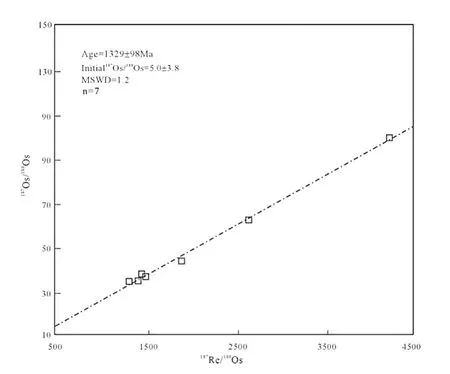
Fig.6 Re-Os isochron of pyrite from Abra deposit

Table 1 The characteristics of samples in Abra deposit
5.2 Pb isotope
The Pb isotope compositions of galena are given in Table 3.206Pb/204Pb variation from 15.914 to 15.967,with an average of 15.929 and variation of 0.3%;207Pb/204Pb range from 15.425 to 15.454,with an average of 15.438 and variation of 0.2%;208Pb/204Pb range from 35.584 to 35.667,with an average of 35.625 and variation of 0.2%.Variations of Pb isotope are.The value ofμwas9.69-9.73,ωwas 37.05-37.47,both of which are higher than normal leadμvalue(8.686-9.238)and normal leadωvalue(35.55+0.59)respectively,Th/U value was 3.70-3.73,and the model age t=1728-1711 Ma.
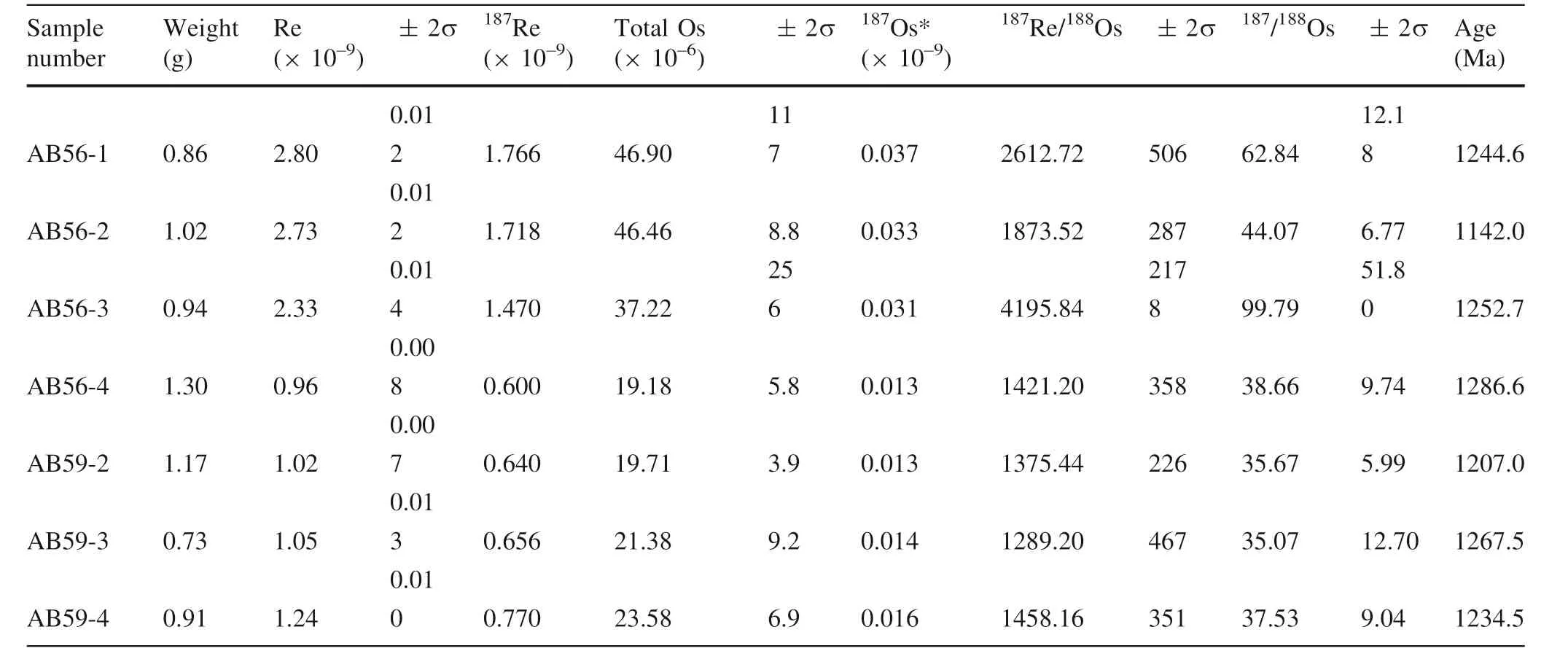
Table 2 Analysis result of Re-Os isotopes with pyrite samples in Abra deposit

Table 3 Pb isotopic compositions of Abra deposit
5.3 H-O isotope
The results of the H-O isotope compositions of 7 quartz samplesare shown in Table 4.The range ofδDV-SMOWwas-35‰to-17‰with an average of-23‰.The range of δ18OV-SMOWwas 12.386‰to 16.161‰with an average of 13.874‰.the range ofδ18Ofluidwas 5.1‰~11.9‰computed through the formula1000lnαquartz-water=3.38×10-6/T2-3.40(Clayton et al.1972).Projecting thedataof theδDV-SMOWandδ18OV-SMOWonto the hydrogen and oxygen isotopediagram,most of thesamples fall within thescopeof themetamorphic water,whileafew were projected in the range of meteoric precipitation.The hydrogen and oxygen isotopic compositions of the ore deposit show that the ore-forming f luid was the mixture of metamorphic water and meteoric f luids,but mainly metamorphic water.

Table 4 H and O isotopic compositions of the Abra deposit
6 Discussion
6.1 Timing of mineralization
The main ore minerals of the Abra deposit are galena,chalcopyrite,and pyrite.Pyrite is in close association with chalcopyrite and galena(Fig.5J,K),thus the pyrite formation time could beregarded asrepresentativeof lead and copper deposits metallogenic epoch.However,the galena Pb isotope model age t=1728-1711 Ma is earlier than the pyrite Re-Os isotopic age value.This is probably because the galena Pb isotopeμandωvalue are higher than normal lead(8.686~9.238)and(35.55±0.59),indicating that the lead in this ore deposit isnot a single stage normal lead,but radioactive anomaly lead.Therefore,the obtained model ageisnot the deposit metallogenic age.In thisstudy,the time lineage obtained by f itting was 1329±98 Ma(MSWD=1.2)with low blank value and high conf idence,it could be the ore-forming age of the ore deposit.
According to Western Australia Bureau(Fig.3),the formation age of the Edmund group is 1620~1465 Ma,but the Abra deposit pyrite formation age is 1329±98 Ma,suggesting that mineralization time is later than the Edmund group.It should belong to epigenetic instead of diagenetic.But from the formation sedimentary sequence the ore deposit should be formed through diagenetic processes,as evidence from the upper stratiform-like lead and silver mineralization body in the spatial distribution in the 4th to 6th lithology section of the upper Edmund Irrigully group,and in the overlying Gooragoora group without mineralization.
How to explain the inconsistent phenomena of geological phenomenon and age data.There are two possibilities.One explanation is that 1329±98 Ma represents the Abra deposit main metallogenic period.The layer control may be due to the overlying strata Gooragoora group contact area has a set of mudstone and shale rock with low permeability,ore-forming f luid did not travel through the horizon,so there was no mineralization in this stratum.The other explanation is that the Abra deposit is syngeneic,but at the same time there may be multiple metallogenic f luid activities,and 1329±98 Ma is only the time of one primary mineralization.
Rasmussen et al.(2010)carried out in situ monazite dating of RBZ and BBZ sandstone to obtain isochronous age of 1385 Ma and argue that it is an important metallogenic f luid activity time.This is because in low temperature(100-550°C)hydrothermal activities,monazite can dissolve and precipitation and growth,thus,serving as a good dating mineral(Rasmussen et al.2001,2005,2007;Harrison et al.2002).If there are multi-phase f luid activities,monazite will have a multiple ring structure or early monazite dissolved by the later f luid.And each zone represents a thermal activity,which revealed that f luid activity was not earlier than 1385 Ma.
Combining previous research results and this work,we support the f irst explain.Because the current age data were later than 1465 Ma,mainly between 1320~1385 Maand thesevalueswere obtained from different mineral samples,which can eliminate the uncertainties caused by using a certain mineral.Moreover,these age values not only have the age values of Re-Os isotope,but also have the age values of monazite and U-Pb,and obtained from different laboratories,which can also eliminate the uncertainties caused by a single dating.
In conclusion,the pyrite Re-Os isotopes and monazite U-Pb dating support each other.Thus,the age data of 1329±98 Ma can represent the main metallogenic age of the Abra deposit.
6.2 Sources of ore metals
Vogt and Stumpf l(1987)considered that the metallogenic material of the Abra deposit is derived from the red and sandstone layers with abundant metallogenic elements in thelower part of thebasin,which issimilar to thesourceof copper in the central African copper belt.Boddington(1990)considered that the origin of metallogenic metallic materials is from the deeply buried rocks,which is a SEDEX type deposit.Pirajno(2004)suggests that the Abra deposit may belong to the SEDEX type,which is derived from the base stratum.Re-Os isotope system can trace the metallogenic material source and the degree of precise instructions were mixed with crustal material(Foster et al.1996);the crust is enriched Re,the involvement of crustal materials causes the radioactive187Os content increasing leading to the increasing of the initial value(Saal et al.1998).The initial value of(187Os/188Os)=5.0±3.8 in thisdeposit ishigher than theoriginal mantle value(0.125),indicating that metallogenic materials originate from the crust.
Pb isotope composition is one of the most direct and effective methods for tracing mineralization,and it has been widely used in the study of various ore deposits(Sun et al.2016;Wang et al.2016).Franco Pirajno et al.(2015)has carried out a study of a suite of Galena separates from four different samplesfrom the Abradeposit.Heconcluded that acrustal sourceand iscompatible with sourcing lead in the Abra deposit from the Edmund Basin.The variations of Pb isotopes are the same as that got by Franco Pirajno et al.(2015)(206Pb/204Pb variation from 15.918 to 15.959;207Pb/204Pb range from 15.426 to 15.448;208Pb/204Pb range from 35.584 to 35.659).And the variations of Pb isotopes of the seven galena are limited,indicating that the lead sourcesin the RBZ,BBZ,ABZ,and CBZ areprobably a single reservoir.In the Zartman lead construction schematic diagram(Fig.7),7 samples almost all falling near the upper crust evolution line,which displays the sources of ore-forming materials lead is the crust.According to the study of sulfur and strontium isotope(Li 2014;He 2013),the metallogenic material Pb,Ag,Cu,Au mainly came from the surrounding rocks.In combination with the Re-Os isotope and Pb isotope characteristics of this deposit,the metallic substance is mainly derived from sedimentary strata such as the red layer and gravel layer at the bottom,which iscarried into the favorable space and deposited into ores.
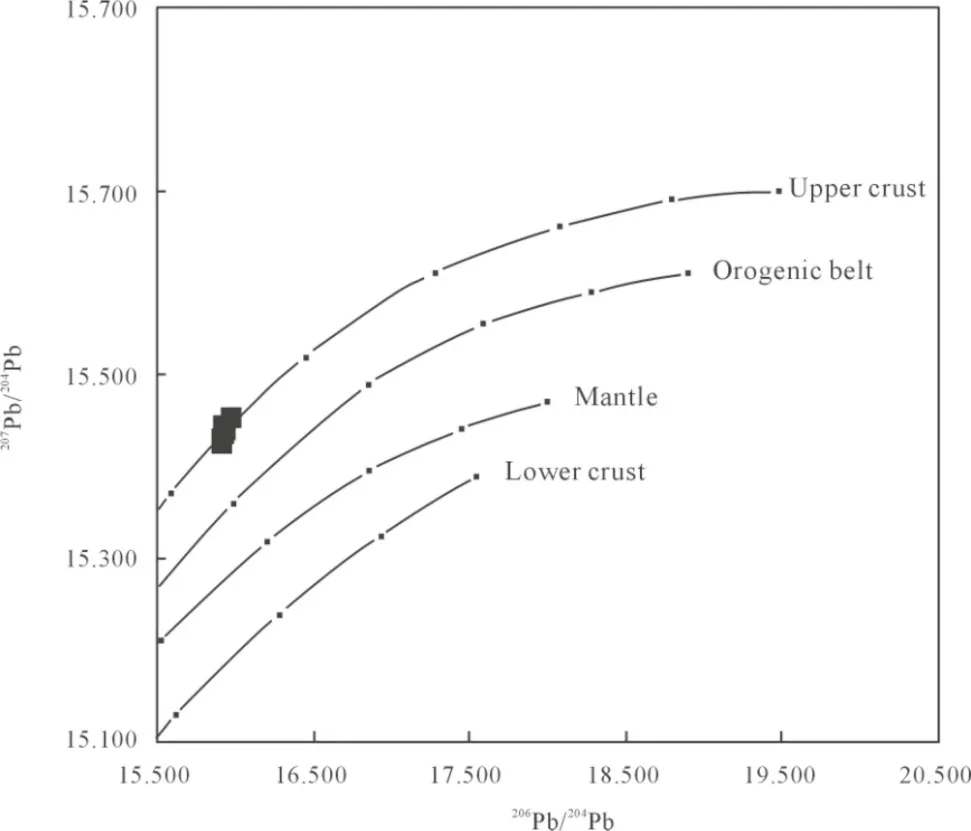
Fig.7 The piumbotectonic model of the Abra deposit(Zartman and Doe 1981)
6.3 Nature and origin of the ore-forming f luids
We carried out a study on Fluid inclusion in RBZ,BBZ,ABZ,and CBZ.Theresultsshowed that(1)f luid inclusions in quartz vein are mainly primary,particle size range 4-8 μm,generally less than 10μm;(2)the RBZ and BBZ are mainly pure liquid inclusions,while the ABZ and the CBZ are about 5%of the gas-liquid two-phase inclusions,and thegasphaseand liquid phaseratio aregenerally 5%-10%;(3)Quantity of inclusions in ABZ and CBZ increased obviously,and some are greater than 20μm;and(4)the average temperature range and salinity of RBZ,BBZ,ABZ,and CBZ are respectively 162-195°C and 6.9%-13.0%,167-190°C and 6.5%-11.2%,173-251°C and 7.0%-19.8%,having the ore-forming f luid characteristics of low temperature and low salinity.According to Li(2014);He(2013),there are mainly two-phase H2O inclusions,inclusions containing CO2and CH4,and threephase inclusions containing mineral,with the size of 2-20μm.Their form is a more irregular shape,elliptical and rectangular,homogenization temperatureand salinity range display characteristics for the low temperature and low salinity.
In theδDV-SMOWandδ18OV-SMOWhydrogen and oxygen isotope diagram(Fig.8),the composition of quartz HO isotopes show that the metallogenic f luid is a mixture of metamorphic water and atmospheric precipitation,and dominated by metamorphic water.In conclusion,the oreforming f luid isthelow temperature,and low salinity f luid,and is the mixed source dominated by metamorphic water and followed by meteoric water.
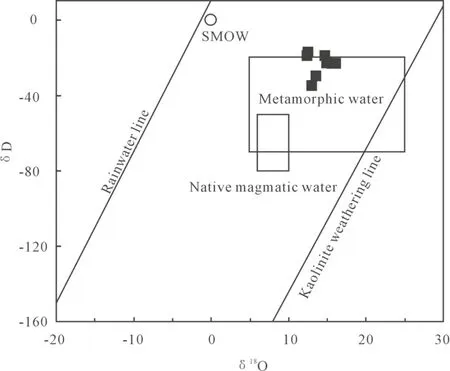
Fig.8 TheδDV-SMOW-δ18OV-SMOW plot of ore-forming f luid in Abra deposit(Taylor 1974)
6.4 Metallogenic model
Due to the increaseof overlying rocksand the deepening of burial depth,the bottommost sediments were gradually compacted and dehydrated,and the salinity of pore water kept increasing in the sedimentary basin.As the sediments continued to be compacted under the inf luence of geothermal gradients,the expandable clay was transformed into non-expandable clay,and metallic materialswere to be extracted from themineralsthrough f luid effect and entered syngenetic water.Whilesedimentswerefurther dehydrated by increasing pressure,on one hand,a large amount of syngenetic water was discharged,and on the other hand,more metals were activated by f luid extraction and entered the syngenetic f luid to form the initial ore-bearing hydrothermal f luid and ore-forming f luid.
West Australia craton underwent long-term,large-scale magmatic activity since 1.43-1.07 Ga.Peregrine dike,dolerite,and rhyolite were well developed in the region.Pirajno(2004)suggests that due to the mantle plume,during this period,the abnormally high geothermal gradient increased f luid activity,strengthened the ability of f luid extraction ore-forming elements,activities,and frequency,and provide the heat source for mineralization.
Above all,in the process of metal material forming orebody,the reductive high-temperature ore-forming f luidcarrying metal ions such as Fe,Pb,Ag,Cu,Au et al.and S2-ion moves from down to up along the fracture and mix with oxidizing f luid from in situ,or top-down migration.Then when the temperature,pressure,and pH changed,it generated metal mineralsand formed orebodiesin favor of spatial precipitation(Fig.9).The Abra deposit should be a low-medium temperature hydrothermal stratabound type deposit.
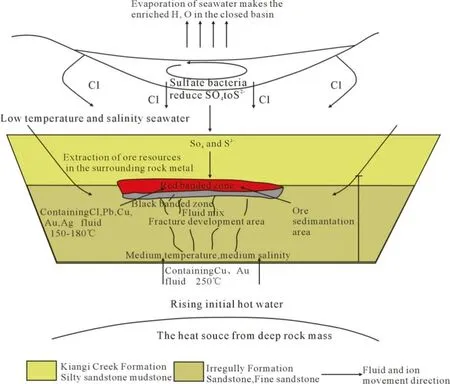
Fig.9 Metallogenic model of the Abra deposit
7 Conclusion
1. The Abra deposit is located at the eastern of the metallogenic belt of the Jillawarra basin in the Bangemall basin in western Australia.The metallogenic belt is an important polymetallic mineral producing area in Western Australia.Abra deposit is mainly composed of upper layer lead-silver ore body and lower net vein copper-gold ore body,the main metal mineral is galena,chalcopyrite and pyrite,main gangue mineral is quartz,dolomite,barite.
2. The pyrite Re-Os isotopic age of the Abra deposit is 1329±98 Ma, the initial value (187Os/188-Os)=5.0±3.8.The galena Pb isotopic compositions(206Pb/204Pb range of 15.914 to 15.914,207Pb/204Pb range of 15.425 to 15.454,208Pb/204Pb range of 35.584 to 35.584)show that metallogenic metals mainly come from the host rock.Based on the previous f luid inclusions results and the quartz H-O isotopeδDV-SMOW(-35‰-17‰),and theδ18OV-SMOW(12.386‰-16.161‰)indicating that the Abra deposit ore-forming f luid belongs to low temperatureand low salinity f luid,the source of which is mainly for metamorphic water and mixed with atmospheric precipitation followed.
3. Reductive low-temperature ore-forming f luid-carrying metal ions such as Fe,Pb,Ag,Cu,Au et al.,and S2-ion mix with an oxidizing f luid.Then when physical and chemical conditions change,it generated metal minerals and form ore bodies.The Abra deposit should be a low-medium temperature hydrothermal stratabound type deposit.
AcknowledgementsThis project was funded by the Joint Fund Projects(U1812402),and the National Natural Science Foundation of China(41103024),and the‘‘Financial Subsidy for Overseas Mineral Resource Risk Exploration in 2010’’project.We give thanks to the two anonymous reviewers for reviewing the manuscript and the editors for providing comments and editorial reversions.
Open AccessThis article is licensed under a Creative Commons Attribution 4.0 International License,which permits use,sharing,adaptation,distribution and reproduction in any medium or format,as long as you give appropriate credit to the original author(s)and the source,provide a link to the Creative Commons licence,and indicate if changes were made.The images or other third party material in this article are included in the article’s Creative Commons licence,unless indicated otherwise in a credit line to the material.If material is not included in thearticle’s Creative Commonslicenceand your intended use is not permitted by statutory regulation or exceeds the permitted use,you will need to obtain permission directly from the copyright holder.To view a copy of this licence,visit http://creativecommons.org/licenses/by/4.0/.
Acta Geochimica2021年5期
- Acta Geochimica的其它文章
- Source characteristics and genesis of Sb mineralization from the Au and Sb deposits of the Youjiang Basin,SW China:constraints from stibnite trace element and isotope geochemistry
- Late Jurassic adakitic ore-bearing granodiorite porphyry intrusions in the Xiaokele porphyry Cu(-Mo)deposit,Northeast China:implications for petrogenesis and tectonic setting
- Mineralogy and geochemistry of the Ngaoundaba Crater Lake sediments,northern Cameroon:implications for provenance and trace metals status
- Geochemistry of platinum-group elements in the podiform chromitites and associated peridotites of the Nain ophiolites,Central Iran:Implications for geotectonic setting
- Geochemistry,geochronology,and zircon Hf isotopic compositions of felsite porphyry in Xiangshan uranium oref ield and its geological implication
- Geochemistry and provenance of the lower-middle pliocene cheleken formation,Iran
